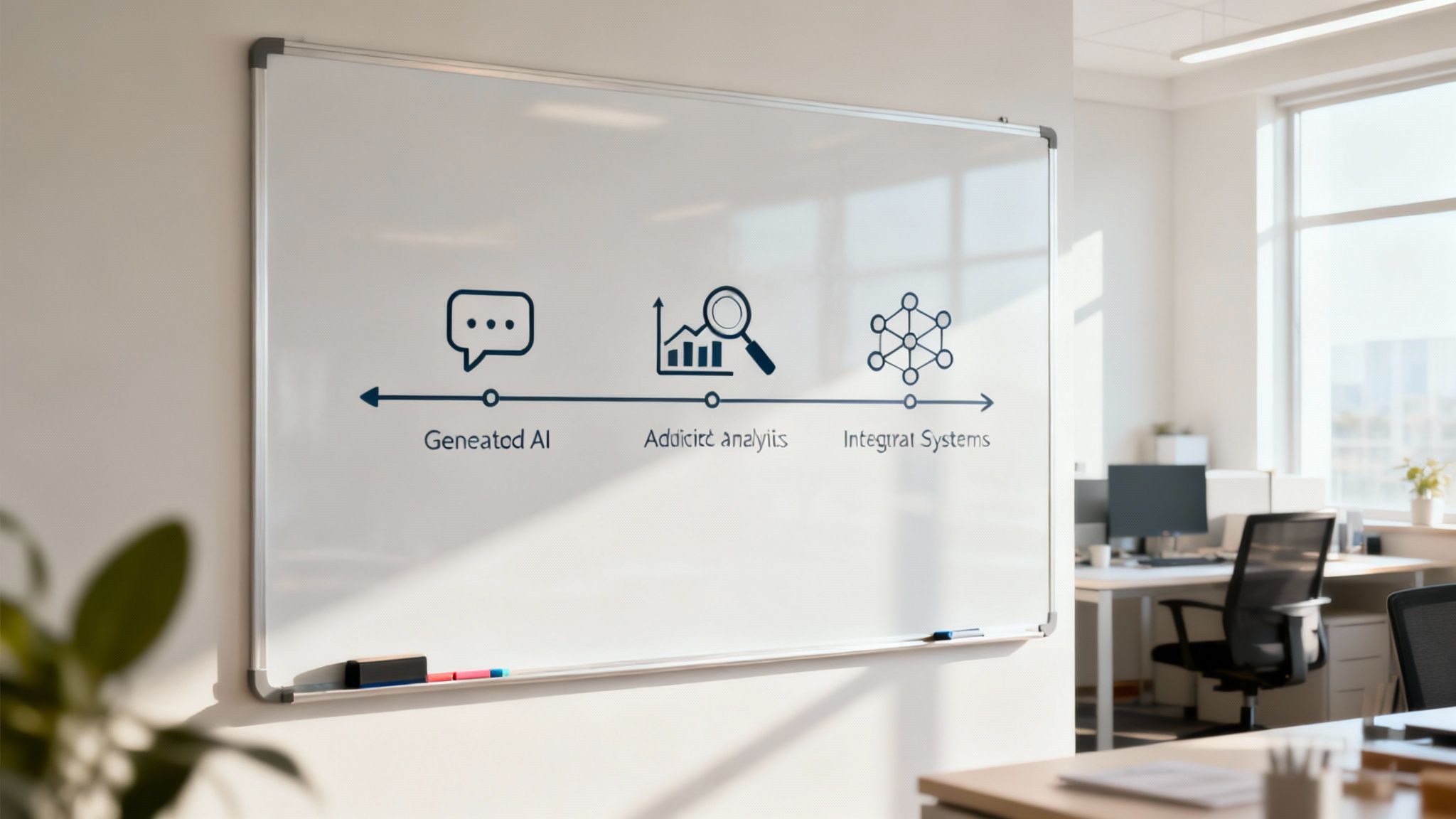Imagine your clinic running like a well-oiled machine, with all the tedious administrative work humming along in the background. This frees up your team to do what they do best: focus on patients. This isn't some futuristic fantasy; it's exactly what AI in healthcare administration is making possible right now. This intelligent automation acts as a new, incredibly efficient partner for your practice—one that tackles the headaches of manual paperwork, endless scheduling conflicts, and costly billing errors that drain resources and morale.
In a healthcare landscape defined by increasing patient loads and mounting administrative pressure, finding a sustainable path forward is critical. AI offers a powerful solution, not by replacing human expertise, but by augmenting it. It provides the tools to streamline the repetitive, rule-based tasks that consume a disproportionate amount of staff time, allowing your talented team to operate at the top of their licenses and focus on high-value, patient-centric work.
Putting AI to Work in Your Healthcare Practice

This guide is designed to show you exactly how AI works in the real world, from automating everyday tasks to the tangible benefits you can expect to see. We’ll also be honest about the challenges of getting started and give you a straightforward roadmap to prepare your practice for this change. Consider this your starting point for seeing why AI is becoming a must-have for any modern, efficient healthcare operation.
This isn't just a passing trend. The numbers tell a powerful story. In 2023, the global AI in healthcare market was already valued at around $19.27 billion. Experts predict it will grow at a stunning 38.5% each year through 2030, potentially hitting nearly $188 billion. This explosive growth shows just how much healthcare is counting on AI to get its administrative house in order and solve long-standing inefficiencies.
Why the Sudden Rush to AI?
Let's be blunt: the administrative burden in healthcare is out of control. Doctors, nurses, and their support staff are drowning in paperwork, spending huge chunks of their week on tasks that have nothing to do with patient care. Studies have shown that for every hour of direct patient care, physicians spend nearly two hours on administrative tasks. This isn't just inefficient; it's a major cause of burnout and a significant barrier to providing timely, effective care.
This is precisely where AI comes in. By taking over the repetitive, mind-numbing tasks, AI directly targets the biggest administrative pain points:
- Slash Manual Errors: AI systems don't get tired or distracted. They handle data entry, medical coding, and claims processing with incredible accuracy, which means fewer rejected claims and faster payments. Human error in billing can cost practices thousands of dollars annually; AI minimizes this risk.
- Let Your Staff Shine: When you automate the tedious work, your administrative team can shift their focus to higher-value roles that require a human touch—like patient relations, complex problem-solving, and care coordination. This not only improves job satisfaction but also leverages their skills more effectively.
- Create a Better Patient Experience: AI tools can manage appointment scheduling, send smart reminders, and handle routine inquiries 24/7. The result is fewer no-shows, reduced wait times, and happier patients who can get the access they need, when they need it.
By handling the high-volume, low-complexity tasks, AI frees up human talent to do what they do best: care for patients and solve complex problems. It’s about augmentation, not replacement.
To see these benefits, it’s helpful to look at the broader strategies for improving business efficiency with proven automation. The basic idea is simple: find the biggest bottlenecks in your workflow and apply the right technology to fix them. The end goal is to build a more responsive and resilient healthcare operation, from the front desk to the billing department.
The table below breaks down some of the most common administrative headaches and shows how AI is providing a real solution.
Key Areas Transformed by AI in Healthcare Administration
| Administrative Area | Traditional Challenge | AI-Driven Solution |
|---|---|---|
| Patient Scheduling | Manual phone calls, high no-show rates, inefficient calendar management. | AI-powered chatbots and portals for 24/7 self-scheduling; predictive analytics to minimize no-shows. |
| Medical Coding & Billing | High potential for human error, complex coding rules, frequent claim denials. | Natural Language Processing (NLP) to analyze clinical notes and suggest accurate codes, reducing errors. |
| Prior Authorization | Slow, manual submission processes that delay patient care and frustrate staff. | Automated systems that check payer rules and submit requests instantly, speeding up approvals. |
| Data Entry & Records | Time-consuming and error-prone transfer of patient information into EHRs. | AI tools that automatically extract data from faxes, forms, and referrals and input it into the correct fields. |
As you can see, AI isn't a single tool but a set of technologies that can be applied to solve specific, long-standing problems that have plagued healthcare administration for years.
How AI Automates Everyday Administrative Tasks

To really get what AI in healthcare administration can do, it helps to pop the hood and see how these tools work. They aren't magic wands; they're specialized systems built to chew through specific, high-volume tasks with incredible speed and accuracy. Think of them as the ultimate digital assistant for your administrative team.
Your staff is made up of smart, capable problem-solvers, but far too often, they’re buried in repetitive, rule-based work. AI is designed to take over that predictable stuff. This frees up your people to use their skills where they're needed most—on complex issues that require a human touch, like navigating a difficult insurance appeal or comforting an anxious patient. This shift is built on AI’s ability to learn from huge amounts of data, spot patterns, and automate the right response. It’s how messy, manual workflows become smooth, efficient operations.
Unpacking AI in Medical Billing and Coding
Medical billing is the perfect example of a critical process that’s often tangled up in manual work. An AI system tackles this like a tireless financial auditor, working 24/7 to catch mistakes before a claim ever goes out the door.
Using Natural Language Processing (NLP)—a fancy term for AI that understands human language—the system can actually read a doctor’s clinical notes. It pulls out key diagnoses and procedures, checks them against the latest coding rules (like ICD-10 and CPT), and suggests the most accurate medical codes. The system can even identify potential compliance risks or opportunities for more specific coding that better reflects the care provided.
This single step drastically cuts down on the human errors that lead to frustrating and expensive claim denials. One study found that clinicians spend nearly 28 hours a week on administrative work alone. By automating the initial coding and review, AI gives a huge chunk of that time back, allowing them to focus on clinical duties.
AI acts as a smart filter, catching potential errors, flagging compliance issues, and ensuring every claim has the highest possible chance of being approved on the first submission. This means faster reimbursements and a healthier revenue cycle.
Getting this right is essential for any modern practice. To see how these pieces fit together, it’s worth exploring the bigger picture of healthcare workflow automation, which provides a blueprint for connecting these different administrative tasks into a cohesive, intelligent system.
Optimizing Patient Scheduling and Communication
Now, think about patient scheduling. Imagine an expert logistics coordinator who can juggle hundreds of moving parts at once. That's exactly what an AI-powered scheduling tool does.
It looks at everything—doctor availability, room assignments, equipment needs, and even patient preferences—to find the perfect appointment slot. The result is shorter wait times for patients, an end to double-bookings, and much better use of your clinic’s resources. Some advanced systems can even predict procedure times based on the patient's condition and the specific physician, creating a hyper-efficient daily schedule.
AI assistants also handle patient communication by sending smart, personalized reminders that are proven to slash no-show rates, which can be a significant drain on revenue.
- Predictive Reminders: The system can analyze a patient’s history and send reminders at the times they’re most likely to see and respond to them.
- 24/7 Self-Scheduling: AI chatbots let patients book, reschedule, or cancel appointments anytime they want, without ever having to call the front desk.
- Intake Automation: Before the visit, AI can walk patients through digital intake forms, making sure all the necessary info is collected accurately and flows right into the EHR. This reduces check-in time and ensures clinicians have the information they need before the appointment even begins.
Managing Electronic Health Records with Intelligence
Finally, let’s look at how AI interacts with Electronic Health Records (EHR). Here, AI is like a brilliant medical librarian who can find the exact piece of information you need from a mountain of data in an instant.
Instead of a doctor manually digging through years of a patient's notes, they can just ask the AI a question in plain English. For example, "Show me this patient's A1C lab results from the last five years," or "Summarize all cardiology consult notes for this patient."
The AI gets the request, scans the entire record in seconds, and pulls up the relevant data in a clean, easy-to-read format. It can even visualize trends, such as charting blood pressure readings over time. This kind of quick access helps clinicians make better, more informed decisions and saves precious time during appointments. These systems also help keep data clean by flagging inconsistencies or missing information that could affect patient care.
So, What's the Real-World Payoff?

Bringing any new technology into your practice has to come with a clear return on investment. With AI in healthcare administration, the benefits aren't just buzzwords; they’re real results you can see in your facility’s financial health, day-to-day operations, and even the quality of your patient care.
This is about more than just making tasks run faster. It’s a fundamental shift in how administrative work gets done. Think of it as trading in slow, manual processes for quick, data-driven workflows that create measurable value everywhere you look. The real magic happens when you connect the dots between the automation humming in the background and the improvements happening on the front lines. When AI takes over the repetitive stuff, it creates a ripple effect that improves everything from billing accuracy to patient happiness.
Driving Down Costs and Slashing Errors
One of the first places you’ll feel AI’s impact is on your bottom line. Manual administrative tasks, especially around billing and claims, aren't just tedious—they’re a minefield for human error. A simple typo can lead to a costly claim denial and hours of rework. Industry estimates suggest that up to 80% of medical bills contain errors, contributing to billions in lost revenue.
AI acts like a powerful quality control checkpoint. It automatically reviews claims for correct coding, compliance with payer rules, and missing information, catching mistakes before they ever go out the door. This smart, proactive approach leads to some big wins:
- Fewer Claim Denials: AI helps you get claims right the first time, which means you get paid faster and your revenue cycle stays healthy. A higher clean claims rate is a direct result.
- Lower Administrative Overhead: Automating tasks like data entry, eligibility checks, and prior authorizations frees up countless staff hours previously lost to paperwork. This allows you to reallocate resources to patient-facing roles.
- Reduced Rework Costs: When your team isn't constantly chasing down denied claims and fixing errors, they can focus on work that actually moves the needle.
By stamping out manual mistakes, AI directly translates into serious cost savings. Cleaner billing means faster payments, better cash flow, and far less time and money wasted on fixing administrative headaches.
This isn't some far-off future, either. The industry is already moving fast. By 2025, a staggering 86% of healthcare providers reported already using AI extensively. Some estimates show the global healthcare AI market could soar past $120 billion by 2028, fueled by its power to untangle complex jobs like claims processing and scheduling. You can discover more about the rapid integration of AI in healthcare and see the numbers for yourself.
Creating Powerful Operational Efficiencies
Beyond the immediate cost savings, AI brings a level of operational smoothness that makes your entire facility run better. It’s like upgrading your practice’s engine—when the engine is more efficient, everything from patient check-in to staff scheduling performs better.
AI helps clear up workflows that have always been major bottlenecks. Take patient intake, for instance. Instead of handing out clipboards, patients can fill out digital forms on their own time, and AI can pull that information directly into the EHR without anyone having to type it in.
This kind of efficiency pops up all over the place:
- Optimized Scheduling: Smart algorithms can juggle complex appointment schedules to minimize patient wait times and make the most of your clinical resources, even predicting patient flow to prevent lobby congestion.
- Faster Insurance Verification: Automated systems can confirm a patient’s insurance eligibility in seconds, preventing billing surprises for everyone and ensuring claims are sent to the right payer.
- Streamlined Prior Authorizations: AI tools can automatically handle prior authorization requests and track their progress, cutting down on care delays that frustrate both patients and providers.
Enhancing the Overall Patient Experience
At the end of the day, the most important benefit of AI in healthcare administration is how it makes things better for the patient. When your administrative processes are smooth, quick, and error-free, people notice. They get shorter wait times, easier scheduling, and clearer communication. A patient who can book an appointment online at 10 PM and get an instant confirmation has a much better impression than one who has to play phone tag with the front desk.
Just as important, when your staff is freed from the grind of repetitive tasks, they have more time and energy to focus on what matters most: the patients. Instead of being buried in paperwork, they can offer a helpful, empathetic presence. That human touch—powered by smarter technology—is what builds trust and keeps patients coming back. A seamless administrative journey sets the tone for a great clinical experience.
Navigating the Hurdles of AI Implementation
Bringing AI into your healthcare practice is a big deal—it’s a fundamental shift in operations, not just another software install. The upsides are huge, but let's be real: the road to getting there has its share of bumps. Thinking about these challenges ahead of time is the secret to a smooth transition and actually getting your money's worth.
This isn't about plugging in a new tool. It’s about weaving a smarter way of working into the very fabric of your daily operations. From figuring out the budget and locking down patient data to getting your team excited about the change, a smart, realistic plan is everything. Let's break down the common roadblocks and talk about how to get around them.
Building the Business Case and Managing Costs
The first thing on everyone's mind is usually the price tag. Yes, AI technology requires an upfront investment, and that can feel like a major hurdle. But the practices that nail this start by framing the cost not as an expense, but as an investment that will pay them back.
Instead of trying to boil the ocean, start small. Pinpoint your single biggest administrative headache. Is it the constant back-and-forth of claim denials? Maybe it's patient no-shows, or the hours your staff burns on prior authorizations? Pick one high-impact problem and run a pilot program with an AI solution. This lets you prove its value on a smaller scale and show a real return on investment (ROI) before you go all-in.
The trick is to stop asking, "How much does AI cost?" and start asking, "How much are our current problems costing us?" When you add up the dollars lost to manual errors, wasted staff time, and delayed payments, the investment in automation often makes financial sense much faster than you'd think.
A phased rollout is your friend here. It helps you spread out the costs, learn as you go, and build excitement as your team starts seeing the wins for themselves. Many AI solutions are also available as Software-as-a-Service (SaaS) models, which means a more predictable monthly subscription instead of a large capital expenditure.
Ensuring Data Security and HIPAA Compliance
In healthcare, patient data is everything. The idea of a new technology touching Protected Health Information (PHI) is serious business, and it needs to be treated that way. When it comes to data security and HIPAA compliance, there are no shortcuts.
When you're looking at AI vendors, your security vetting has to be intense. You're not just buying a product; you're trusting a partner with your patients' most private information. You have to get past the sales pitch and ask the hard questions.
Here’s a quick checklist for vetting potential AI partners:
- Business Associate Agreement (BAA): This is table stakes. If a vendor won’t sign a BAA, walk away.
- Encryption Standards: Make sure all data is locked down with strong, end-to-end encryption, both when it's being sent and when it's stored.
- Access Controls: How does the tool control who sees what? It needs to have role-based permissions so staff only access the PHI they absolutely need to do their jobs.
- Audit Trails: The system must keep detailed logs of who accessed data, what they did, and when. This is non-negotiable for security and compliance.
Making sure your AI partner is secure is step one. You can dive deeper into finding platforms that put security first by checking out our guide on what makes an AI HIPAA compliant. Securing patient data isn’t just a legal checkbox—it’s the foundation of patient trust.
Managing the Human Side of Change
The technology is only half the battle. The other, and arguably more important, half is your team. The best AI tool on the planet is useless if your staff doesn't get it, doesn't trust it, or doesn't want to use it. Nailing this cultural shift is what separates a successful implementation from a failed one.
Start by explaining the "why." Make it clear that the goal isn't to replace people but to give them superpowers. Frame the AI as a new teammate that will handle the most boring, repetitive tasks, freeing them up to focus on what matters most: helping patients. Show them how the tool will reduce their personal pain points.
Good training is essential, and it can't be a one-and-done webinar. Think ongoing support. Offer hands-on workshops, create simple cheat sheets, and make sure everyone knows who to ask for help. Identify "super-users" or champions within your team who can advocate for the new technology and assist their peers. Create a space for people to ask questions and share their concerns. When your team feels supported and heard, they’re much more likely to get on board. This simple focus on people can turn resistance into real enthusiasm.
Preparing Your Practice for the Future of AI

The AI tools changing healthcare administration today are really just the first wave. What’s coming next is a new generation of intelligent systems that will blur the lines between administrative tasks and clinical care in ways that make today’s tech look simple. Getting your practice ready now isn’t just about keeping up—it’s about building a solid foundation for whatever comes next.
Think beyond just scheduling or billing. The next frontier is generative AI handling far more sophisticated work, like instantly drafting personalized follow-up emails to patients, summarizing a patient's entire medical history into a clean paragraph for a referral, or even predicting which patients are at high risk of missing appointments based on complex data patterns. This is the direction AI in healthcare administration is headed.
And this isn't some far-off fantasy. A recent global survey of healthcare executives revealed that over 80% believe generative AI will have a major impact on their organizations within the next year. It's happening so fast that regulatory bodies like the US FDA and the European Union are already building frameworks to manage AI in healthcare. You can read more about the 2025 executive outlook to see how leaders are getting ready.
Building a Future-Ready Foundation
To prepare for what's ahead, your organization needs to become comfortable and fluent with data. It all starts with cleaning up and standardizing your data practices today. Future AI systems need high-quality, structured data to work their magic, so think of this as tilling the soil before you plant the seeds. This means establishing consistent data entry protocols and ensuring information is captured accurately across all systems.
The ultimate aim is to have information flow seamlessly between departments, where administrative data helps inform clinical decisions and clinical outcomes feed back into administrative workflows. That integration is what unlocks the next level of efficiency and patient care. An integrated data ecosystem allows for more powerful predictive analytics and a truly holistic view of the patient journey.
Roadmap to AI Integration in Healthcare Administration
Jumping into advanced AI isn’t a one-day project. It requires a clear, step-by-step plan. A phased roadmap helps make the transition feel manageable, builds momentum, and keeps daily operations running smoothly.
This simple framework can help guide your practice on its journey.
| Phase | Key Actions | Primary Goal |
|---|---|---|
| Phase 1: Assessment | Pinpoint your biggest administrative headaches. Check the quality of your current data and tech setup. | Find your biggest pain points and create a starting point for measuring success. |
| Phase 2: Foundation | Create standard rules for collecting data. Train staff on basic data concepts. Run a small pilot project. | Build a strong data infrastructure and show how AI can help, even on a small scale. |
| Phase 3: Expansion | Connect AI with your main systems, like the EHR. Roll out successful pilots to other departments. | Widen AI's impact by plugging it into your core operational systems. |
| Phase 4: Optimization | Track AI performance with clear metrics. Look into more advanced tools like predictive analytics and generative AI. | Fine-tune how you use AI and start getting ready for the next generation of smart technology. |
By breaking the process down, your organization can move into the future with confidence.
The future of AI in healthcare administration isn’t about replacing people. It’s about creating a powerful partnership between your team and technology, giving them tools that amplify their skills and free them up to focus completely on patients.
The key is to start now. Clean your data, train your team, and think strategically about where AI can make the biggest difference. Taking these steps today ensures you won’t just be ready for the future—you'll be helping to shape it.
So, How Do You Get Started?
We’ve seen how AI in healthcare administration can genuinely modernize a practice. It's a powerful way to automate repetitive tasks, save real money, boost efficiency, and give your patients a much better experience. The key thing to remember is this: bringing AI into your practice is completely doable, no matter how big or small your organization is.
You don't need to rip out your entire system and start from scratch. In fact, that's usually a recipe for disaster. The smartest way forward is to start small and build from there. Look for that one administrative headache that's a constant drain on your team's time and morale.
Find Your Biggest Pain Point
Is your front desk staff drowning in phone calls? Are claim denials silently chipping away at your bottom line? Maybe patient no-shows are throwing your entire schedule into chaos every week. Pick the one area where a single improvement would have the biggest impact. Focusing on one problem lets you concentrate your efforts and get a clear, quick win.
Once you’ve zeroed in on the main challenge, you can look for AI tools built specifically to solve it. For instance, if the phone just won't stop ringing, you could look into an AI front desk that can handle appointments and answer common questions around the clock. If prior authorizations are the bottleneck, an automation tool for that specific task is an ideal starting point.
Remember, the goal here is progress, not perfection. A small, successful test run builds confidence, gets your team excited, and makes a strong case for investing more in AI down the road.
A Step-by-Step Path to Success
Starting with a small pilot project is the best way to dip your toes in the water. It’s a low-risk, high-reward strategy that lets you test the technology, train a few staff members, and see the results for yourself without a massive upfront commitment.
- Set a Specific Target: What do you want to accomplish? It could be something like cutting no-show rates by 15% or reducing the time spent on prior authorizations by 25%. Be clear and establish a baseline before you begin.
- Track Everything: Measure your progress against that target. Hard numbers are the best way to prove the tool is working and justify rolling it out further.
- Listen to Your Team: Get your staff involved right from the start. Their feedback is gold and will make the entire process much smoother. They are the experts on the current workflow and can provide invaluable insights.
By taking these first careful steps, you can start building a smarter, more efficient practice. This frees up your team to focus on what really matters: caring for your patients.
Frequently Asked Questions About AI in Healthcare
Whenever a major new technology comes along, it’s natural to have questions. For practice managers, clinicians, and administrative staff, the idea of bringing AI into healthcare administration raises some big ones. People want to know how it will really affect their day-to-day jobs, patient privacy, and the practice's bottom line.
Getting these questions out in the open is the first step toward a smooth and confident transition. Let's tackle some of the most common concerns head-on.
Will AI Replace Our Administrative Staff?
This is usually the elephant in the room, so let's be direct: no. The purpose of AI isn't to replace your team, but to empower them.
Think of AI as a highly efficient assistant that takes on the repetitive, predictable tasks that bog people down and lead to burnout. It's perfect for things like initial data entry, sorting routine emails, or processing simple claims.
By automating that work, your staff is freed up to focus on the things that truly require a human touch—empathy, complex problem-solving, and critical thinking. Instead of spending hours verifying insurance eligibility, a team member can now dedicate that time to helping a patient navigate a complicated billing issue. AI handles the grunt work so your people can shine. The nature of their jobs will evolve from task-doers to problem-solvers.
How Does AI Handle Patient Data and HIPAA?
Patient privacy is everything. Any serious AI tool built for healthcare has HIPAA compliance baked into its very core. These platforms are engineered from day one to protect sensitive information with multiple layers of security.
Here’s what you should look for as standard practice:
- End-to-End Encryption: This keeps data scrambled and unreadable, whether it's being sent or just sitting on a server.
- Secure Access Controls: Only authorized users can see specific information, based on their role.
- Data Anonymization: Personal details are stripped out of data sets whenever possible, especially when used for training AI models.
- Regular Security Audits: Reputable vendors will conduct third-party audits to verify their security posture.
When you're looking at different AI vendors, do your homework. Insist they sign a Business Associate Agreement (BAA) and ask for proof of their security track record. You need to know they are fully prepared, both legally and technically, to handle protected health information.
How Can a Small Clinic Afford to Start Using AI?
The thought of an "AI implementation" can sound expensive, especially for smaller practices. But getting started with AI in healthcare administration doesn't have to mean a massive upfront investment. The smartest way to begin is to start small.
Pick one specific, nagging problem and solve it. Are patient no-shows a constant headache? An AI-powered reminder system can deliver a quick return on investment. Are claim denials chipping away at your revenue? An AI tool that helps with medical coding could be the perfect first step.
Many of the best AI tools are now sold as subscription services (SaaS). This lets you start with one affordable tool, prove its value, and then expand as your clinic grows and your budget allows.
This "start small, prove value" approach makes AI accessible for practices of any size. If you want to dig deeper into what different types of AI can do, this guide to understanding AI features is a great resource.
Ready to see how AI can transform your practice's administrative workflow? Simbie AI offers a clinically-trained voice AI that automates tasks like scheduling, intake, and prior authorizations, freeing your staff to focus on patient care. Discover how you can reduce administrative overhead by up to 60% and eliminate missed calls at https://www.simbie.ai.

